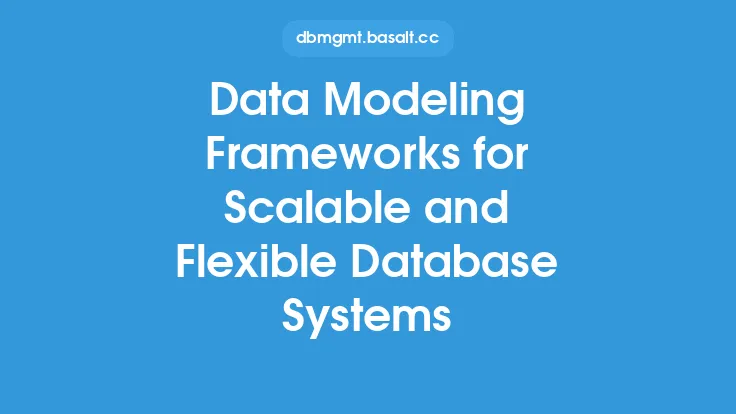When designing a database, one of the most critical aspects to consider is scalability. A scalable database is one that can handle increased traffic, data, and user growth without compromising performance. To achieve this, it's essential to apply data modeling principles that prioritize flexibility, efficiency, and adaptability. In this article, we'll delve into the key principles of data modeling for scalable database design, exploring the concepts, techniques, and best practices that enable databases to grow and evolve with ease.
Introduction to Scalable Database Design
Scalable database design is about creating a database architecture that can accommodate growing demands without requiring significant rearchitecture or redesign. This involves considering factors such as data volume, user concurrency, query complexity, and storage capacity. A well-designed scalable database can handle increased loads, reduce latency, and improve overall system performance. To achieve this, data modeling principles play a crucial role in shaping the database's structure, organization, and relationships.
Data Modeling Principles for Scalability
Several data modeling principles are essential for designing scalable databases. These include:
- Separation of Concerns: Divide the database into smaller, independent components, each responsible for a specific function or dataset. This modular approach enables easier maintenance, updates, and scaling.
- Data Distribution: Distribute data across multiple servers or nodes to improve performance, reduce latency, and increase storage capacity. Techniques like sharding, replication, and partitioning can help achieve this.
- Data Normalization: Normalize data to minimize redundancy, improve data integrity, and reduce storage requirements. This involves applying normalization rules, such as 1NF, 2NF, and 3NF, to ensure data consistency and scalability.
- Denormalization: Apply denormalization techniques judiciously to improve query performance, reduce join operations, and enhance data retrieval. However, be cautious not to compromise data integrity or introduce redundancy.
- Indexing and Constraints: Use indexing and constraints to improve query performance, ensure data consistency, and enforce business rules. Proper indexing can significantly reduce query execution times, while constraints help maintain data integrity.
Entity-Relationship Modeling for Scalability
Entity-Relationship (ER) modeling is a fundamental aspect of data modeling, and it plays a critical role in designing scalable databases. ER modeling involves identifying entities, attributes, and relationships between them. To ensure scalability, consider the following ER modeling principles:
- Entity Identification: Identify entities that are likely to grow or change frequently, such as customer data or order information. Design these entities to be flexible and adaptable to accommodate future changes.
- Attribute Selection: Select attributes that are essential for the entity, and avoid redundant or unnecessary attributes. This helps reduce storage requirements and improve data retrieval performance.
- Relationship Modeling: Model relationships between entities carefully, considering factors like cardinality, optionality, and dependency. This helps ensure data consistency and scalability.
Data Warehousing and Scalability
Data warehousing is a critical aspect of scalable database design, as it involves storing and analyzing large volumes of data. To ensure scalability in data warehousing, consider the following principles:
- Star and Snowflake Schemas: Use star and snowflake schemas to optimize data storage and query performance. These schemas help reduce data redundancy, improve data retrieval, and enhance query performance.
- Fact and Dimension Tables: Design fact and dimension tables to store data efficiently, using techniques like aggregation and summarization to reduce data volume.
- Data Partitioning: Partition data to improve query performance, reduce storage requirements, and enhance data retrieval. Techniques like range partitioning, list partitioning, and hash partitioning can help achieve this.
NoSQL and Scalability
NoSQL databases have gained popularity in recent years due to their ability to handle large volumes of unstructured or semi-structured data. To ensure scalability in NoSQL databases, consider the following principles:
- Document-Oriented Design: Design document-oriented databases to store data in a flexible, self-describing format. This helps improve data retrieval performance, reduce storage requirements, and enhance scalability.
- Key-Value Stores: Use key-value stores to store data in a simple, efficient format. This helps improve data retrieval performance, reduce storage requirements, and enhance scalability.
- Graph Databases: Design graph databases to store complex relationships between data entities. This helps improve query performance, reduce storage requirements, and enhance scalability.
Best Practices for Scalable Database Design
To ensure scalable database design, follow these best practices:
- Monitor and Analyze Performance: Monitor and analyze database performance regularly to identify bottlenecks, optimize queries, and improve scalability.
- Use Indexing and Caching: Use indexing and caching to improve query performance, reduce latency, and enhance scalability.
- Implement Data Compression: Implement data compression to reduce storage requirements, improve data retrieval performance, and enhance scalability.
- Use Distributed Database Systems: Use distributed database systems to improve performance, reduce latency, and enhance scalability.
- Continuously Refactor and Optimize: Continuously refactor and optimize the database design to ensure it remains scalable, efficient, and adaptable to changing requirements.
Conclusion
Designing a scalable database requires careful consideration of data modeling principles, entity-relationship modeling, data warehousing, NoSQL databases, and best practices. By applying these principles and techniques, you can create a database that can handle growing demands, improve performance, and reduce latency. Remember to continuously monitor and analyze performance, refactor and optimize the design, and stay adaptable to changing requirements. With a well-designed scalable database, you can ensure your system remains efficient, effective, and responsive to user needs, even as it grows and evolves over time.





